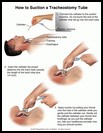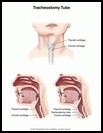
Tracheostomy
What is a tracheostomy?
A tracheostomy is a surgical procedure that creates an opening in your child's neck and windpipe (trachea). It may also be called a tracheotomy. A tube is then placed in the opening to keep it open. The procedure helps get air to your child's lungs.
The term tracheostomy may be used to refer both to the procedure and to the opening created by the procedure.
When is it used?
A tracheostomy may be done when your child has a problem with the airway. If the upper airway is blocked, a tracheostomy can bypass the blockage to provide airflow to the lungs. It is also used to provide oxygen to the lungs more efficiently and to clear secretions from the airway.
Examples of when your child might need this procedure include:
- The upper airway is blocked by swelling, a tumor, vocal cord problems, or a severe narrowing of the trachea.
- Your child will be on a breathing machine (ventilator) for a long time.
- Your child has a injury to the neck, head, or spinal cord that causes severe breathing problems.
- your child has lots of secretions or too much saliva that he cannot get rid of and so he needs frequent suctioning of the airway.
What happens during the procedure?
A tracheostomy is usually done in an operating room or in an intensive care unit. Your child's heart and oxygen levels are monitored during the procedure.
First your child is given an anesthetic. The anesthetic should keep your child from feeling pain during the procedure. Then the surgeon makes a cut (incision) in the neck and trachea in the area of the neck below the Adam's apple and voice box (larynx). A tube is placed in the opening. The tube is held in place with a band or laces around the neck.
What happens after the procedure?
The tracheostomy site will begin to heal and the surgeon will monitor your child for a few days. The original tube is usually kept in place for 5 to 10 days. After that a new tube may be used.
If your child is on a ventilator, the tube may have a balloon around it that prevents air from leaking. In this case your child will not be able to talk. If no ventilator is needed, a smaller tube may be used that allows air to pass around it. In this case your child may be able to talk.
When the tracheostomy is no longer needed, the surgeon will simply remove the tube and cover the stoma with a dressing. You will be instructed how often to change it and what type of dressing or bandage to use. If the stoma (hole) does not close by itself in 4 to 6 months, a minor surgery may be needed.
How is a tracheostomy cared for?
If your child still has the tracheostomy when he goes home from the hospital, your healthcare provider will teach you or your family how to care for the tracheostomy. This will include cleaning the tracheostomy site, suctioning, and changing the tube.
What are the complications?
Possible complications of a tracheostomy are:
- bleeding
- infection
- damage to the larynx
- trouble swallowing
- scarring.
When should I call my child's healthcare provider?
Call IMMEDIATELY if:
- You cannot replace the trach tube after you change it. Try a smaller tube and if that does not work, place a suction catheter into the stoma about 2 inches (5 cm). Tape it in place to keep the stoma from closing further. This makes replacement in the hospital easier.
- You see a lot of bleeding around the tracheostomy. A small amount of bleeding may occur with a trach change but should stop within a few minutes.
- Your child has uncontrollable coughing or cannot breathe easily after suctioning and changing the trach tube.
Call during office hours if:
- The secretions are yellow or green, are thicker than usual, or if they have an unusual or bad smell. (The first 1 or 2 hours in the morning, the secretions may be yellowish, but they should soon become a clear or white color.)
- Your child has changes in swallowing or breathing, sounds from trach tube, or coughing that is not relieved by suctioning.


